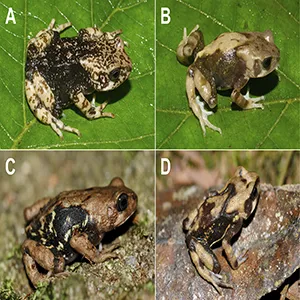
Three new frog species found that give birth to fully-formed frogs, skipping the tadpole stage
Not all frogs lay eggs that hatch into wiggly tadpoles, and not all tadpoles slowly morph into adult frogs in a pond. In fact, some frogs skip that entire stage altogether – like the newly discovered species found in the forests of Tanzania.
Three species of African frogs have been found giving birth to fully formed baby toads. There were no eggs or tadpoles – just tiny versions of themselves, ready to hop away.
New kind of frog life
Study co-author Professor Mark D. Scherz is a herpetologist at the Natural History Museum of Denmark.
“It’s common knowledge that frogs grow from tadpoles – it’s one of the classic metamorphosis paradigms in biology,” explained Professor Scherz.
“But the nearly 8,000 frog species actually have a wide variety of reproductive modes, many of which don’t closely resemble that famous story.”
That includes these Tanzanian toads, which give live birth inside damp forests in the Eastern Arc Mountains.
This unusual method of reproduction is known in only a few other frog species, mostly from South America and Southeast Asia. That’s why scientists were so surprised to find three new species in this one corner of Africa.
H. Christoph Liedtke of the Spanish National Research Council studies the evolution of how amphibians reproduce.
“Live-bearing is exceptionally rare among frogs and toads, practiced by less than 1% of frogs species, making these new species exceptionally interesting,” said Liedtke.
Finding the new frog species
The story of these live-birthing toads didn’t start in a lab – it began in a museum. Over 120 years ago, a German scientist named Gustav Tornier discovered a Tanzanian frog that gave birth to live young.
The species became part of the collections at the Museum für Naturkunde in Berlin. But until recently, scientists weren’t exactly sure how those frogs fit into the bigger family tree.
That changed when researchers used a technique called museomics to extract DNA from those century-old museum specimens.
By studying the DNA, they could match those old frogs to present-day populations and find out how they’re related.
“Some of these specimens were collected over 120 years ago,” said Dr. Alice Petzold of the University of Potsdam, who led the DNA analysis.
“Our museomics work was able to reveal exactly which populations those old specimens belonged to, giving us a lot more confidence for future work on these toads.”
Unrecognized toad diversity
The DNA also confirmed what scientists had suspected. There were more species of these frogs than anyone realized.
To sort it out, Christian Thrane from the University of Copenhagen examined hundreds of preserved frogs in natural history museums.
“Phylogenetic work from a few years ago had already let us know there was previously unrecognized diversity among these toads,” said Thrane, lead author of the study.
“But by traveling to different natural history museums and examining hundreds of preserved toads, I was able to get a better idea of their morphological diversity, so we could describe these new species.”

Frog species in a fragile habitat
The Eastern Arc Mountains of Tanzania are lush, green, and packed with species found nowhere else on Earth.
These forests rise up like islands above the plains, creating cool, damp environments where frogs and other wildlife thrive. But those forests are shrinking.
Many of the tree toads in this region live in small patches of forest that are now surrounded by farmland, mines, or cleared land. This puts them at serious risk.
Dr. Michele Menegon, a conservationist who works in the area, pointed out that the forest is now highly fragmented – and that this is putting the toads in trouble.
In fact, one species in this group, Nectophrynoides asperginis, is already extinct in the wild. Another, Nectophrynoides poyntoni, hasn’t been seen since it was first discovered in 2003.
Some of these frogs are already disappearing, and we’ve only just started to understand them. Each new discovery feels like a small window opening, and the more we learn, the better shot we have at keeping that window from closing for good.
The full study was published in the journal Vertebrate Zoology.
—–
Like what you read? Subscribe to our newsletter for engaging articles, exclusive content, and the latest updates.
Check us out on EarthSnap, a free app brought to you by Eric Ralls and Earth.com.
—–













